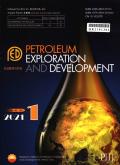Impact rock-breaking mechanisms and energy transfer laws of conical tooth bits in hot dry rocks
IF 8
Q1 ENERGY & FUELS
引用次数: 0
Abstract
Based on the finite-discrete element method, a three-dimensional numerical model for axial impact rock breaking was established and validated. A computational method for energy conversion during impact rock breaking was proposed, and the effects of conical tooth forward rake angle, rock temperature, and impact velocity on rock breaking characteristics and energy transfer laws were analyzed. The results show that during single impact rock breaking with conical tooth bits, merely 7.52% to 12.51% of the energy is utilized for rock breaking, while a significant 57.26% to 78.10% is dissipated as frictional loss. An insufficient forward rake angle increases tooth penetration depth and frictional loss, whereas an excessive forward rake angle reduces penetration capability, causing bit rebound and greater energy absorption by the drill rod. Thus, an optimal forward rake angle exists. Regarding environmental factors, high temperatures significantly enhance impact-induced rock breaking. Thermal damage from high temperatures reduces rock strength and inhibits its energy absorption. Finally, higher impact velocities intensify rock damage, yet excessively high velocities increase frictional loss and reduce the proportion of energy absorbed by the rock, thereby failing to substantially improve rock breaking efficiency. An optimal impact velocity exists.
干热岩石中锥形齿钻头冲击破岩机理及能量传递规律
基于有限离散元法,建立了轴向冲击破岩的三维数值模型并进行了验证。提出了冲击破岩过程能量转换的计算方法,分析了锥齿前倾角、岩石温度、冲击速度对岩石破岩特性和能量传递规律的影响。结果表明:锥形齿钻头在单次冲击破岩过程中,破岩能量仅占总能量的7.52% ~ 12.51%,其中57.26% ~ 78.10%的能量以摩擦损失的形式耗散;前前倾角不足会增加钻齿深度和摩擦损失,而前前倾角过大则会降低钻齿能力,导致钻头反弹和钻杆吸收更多能量。因此,存在一个最优前倾角。在环境因素方面,高温显著增强了冲击破岩。高温造成的热损伤降低了岩石的强度,抑制了岩石的能量吸收。最后,较高的冲击速度会加剧岩石的损伤,但过高的冲击速度会增加岩石的摩擦损失,降低岩石吸收能量的比例,从而无法大幅提高岩石的破岩效率。存在一个最佳冲击速度。
本文章由计算机程序翻译,如有差异,请以英文原文为准。
求助全文
约1分钟内获得全文
求助全文

 求助内容:
求助内容: 应助结果提醒方式:
应助结果提醒方式:


